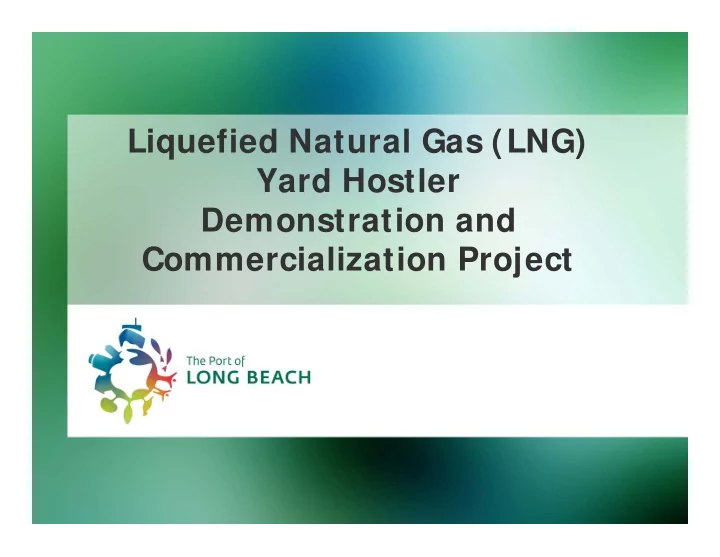

Liquefied Natural Gas (LNG) Yard Hostler Demonstration and Commercialization Project
Project Team Project Team • Port of Long Beach • Sound Energy Solutions • WestStart-CALSTART • Long Beach Container Terminal, Inc. • United States Environmental Protection Agency – Awarded $75,000 to project • Total project cost: approximately $1 million
Project Goals Project Goals • Assess performance and emissions of LNG yard hostlers – Fuel Economy – Operator Acceptance – Service and Maintenance – Compare relative emissions to diesel yard hostlers – Business Case
Test Program Overview Test Program Overview • Performance and emissions testing on 3 LNG yard hostlers • Baseline comparison group: Eight diesel yard hostlers • In-use testing conducted over 8 months (June 2006 – January 2007) • Training provided to LBCT staff • Temporary LNG refueling infrastructure – 3,450 gallon ORCA™ parked in “fixed” location • Fuel economy data collected daily • Drivers and mechanics surveyed • Emissions testing and analysis performed by UCR CE-CERT
Fuel Economy Fuel Economy • Energy content of LNG < diesel, for direct comparison LNG gallons converted to diesel gallon equivalents (DGE) • Average Fuel Economy – 8 diesel yard hostlers: 1.7 diesel gal/hr – 3 LNG yard hostlers: 3.8 LNG gal/hr = 2.2 DGE/hr • Conclusions – LNG yard hostlers use about 30% more DGE than diesel yard hostlers – Expected with heavy-duty spark-ignited engine vs. compression-ignited diesel engine
Operator Acceptance Operator Acceptance • 97% felt LNG yard hostlers performed same or better than traditional diesel yard tractors • 67% of drivers rated LNG yard hostlers superior in general • Only Cab entry and exit frequently rated “worse” than diesel yard hostlers • Some cited slow acceleration, vehicle “hesitation” and problems with shifting
Maintainability and Serviceability Maintainability and Serviceability • 100% of mechanics rated LNG yard hostlers “acceptable” • Routine maintenance performed several times during performance testing period • Noted LNG pressure regulation and leaking problems during early phase of demonstration – Westport Innovations upgraded on-vehicle LNG fueling system to address problems
Emissions Testing Emissions Testing • Compared emissions between LNG and diesel yard hostlers – 2005 LNG on-road engine – Tier 1 diesel off-road engine (2) – Tier 2 diesel off-road engine – 2005 diesel on-road engine • Steady-state emissions testing on heavy-duty chasis-dynamometer • Followed CARB’s yard hostlers emissions testing protocol • Emissions Testing performed by UCR CE-CERT
Emissions Testing Results Emissions Testing Results • By agreement, PM emissions were not tested • Lowest NOx emissions produced by 2005 on-road diesel yard hostler • NOx emissions from LNG yard hostler approximately 21% higher than 2005 on-road diesel yard hostler – Possible explanation: LNG engine running “lean” at higher loads - higher engine temperature and higher NOx emissions NOx Engine Year/Model Fuel Type (g/whp-hr)* 2005 ISB 5.9L Diesel 2.94 2005 C-Gas 8.3L LNG 3.57 * Values shown in units of grams per wheel-horsepower-hour
Comparison with Earlier Study Comparison with Earlier Study • CARB, POLA, and PMSA conducted study of yard hostlers in 2006 • Diesel, liquefied petroleum gas (LPG or propane), and LNG-fueled yard hostlers • NOx emissions from LNG yard hostler higher compared to diesel yard hostler in POLA study • NOx emissions slightly lower (approximately 18%) in this study compared to POLA study POLB Study POLA Study Fuel Engine Year/Model Type NOx PM NOx PM 2004 ISB 5.9L Diesel --- --- 2.47 0.10 2005 ISB 5.9L Diesel 2.94 0.10 --- --- 2005 C-Gas 8.3L LNG 3.57 --- 4.36 0.008 * Values shown in units of grams per wheel-horsepower-hour (g/whp-hr)
Business Case Assessment Business Case Assessment • LNG yard hostlers not currently offered as standard commercial product • New diesel yard hostler typically $65K-$80K • Assuming avg. base cost of $80K, incremental cost for LNG yard hostler approximately $40K (50% of base cost) = $120K • Life cycle cost analysis: diesel and LNG yard hostler approximately equal over 10-year life • LNG fueling infrastructure costs (est. $700k per station) and 2010 emissions regulation compliance not considered • Permitting process for LNG fueling infrastructure can vary • Demand unlikely without financial or regulatory incentives
Recommendations Recommendations • Measure LNG vs. diesel yard hostler emissions using yard hostlers with current engines that meet (or exceed) heavy-duty emissions standards • Evaluate in-use performance of new LNG yard hostlers • Update business case analysis with actual costs for new LNG yard hostlers • Optimize refueling procedures for LNG yard hostler fleets • Consider port-based incentives to address incremental costs of LNG yard hostlers and capital costs of LNG refueling infrastructure
Next Steps Next Steps • Emissions testing on: – 2007 on-road diesel engine yard hostler – diesel engine yard hostlers converted to operate on LNG fuel • Develop standard yard hostler duty cycle, available late summer
Thank you!
Recommend
More recommend